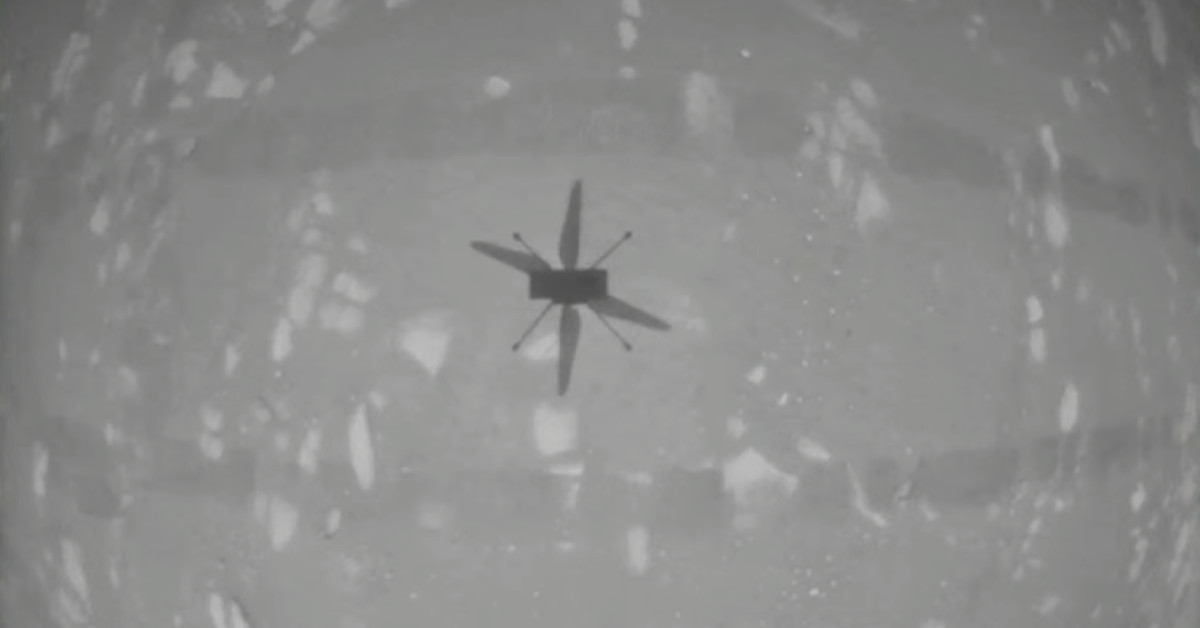
NASA’s Ingenuity helicopter made a successful test flight on Mars, engineers confirmed early Monday morning. The small spacecraft lifted itself 3 meters from the surface of Mars for about 40 seconds, marking the very first powered flight on another world. The historic demonstration opens up tantalizing possibilities for a new way of traveling on the planet that could send future helicopters far beyond the reach of traditional rovers.
The four-pound Ingenuity helicopter lifted its tissue box-sized body at around noon Mars time (around 3:30 a.m. ET) and spun its twin rotor blades to achieve its maiden flight in Mars’ ultra-thin atmosphere, faster than 2,500 rpm – much faster than the roughly 500 RPM it takes to fly on Earth. The rotorcraft arrived on the Red Planet on Feb. 18, clinging to the underbelly of NASA’s Perseverance rover. It was deployed from Perseverance more than a month later on April 4 and started a 31-day clock to conduct five flight tests.
Engineers at NASA’s Jet Propulsion Laboratory erupted in cheers when they confirmed Ingenuity’s escape attempt was a success. “Confirmed that Ingenuity has completed its maiden flight of a powered aircraft on another planet,” Downlink engineer Michael Starch said. “We can now say that humans have flown a helicopter on another planet,” Ingenuity project manager MiMi Aung told NASA engineers in mission control after confirming the helicopter’s successful test flight.
“This gives us great hope for all of humanity. I couldn’t be prouder, ”tweeted Thomas Zurbuchen, NASA’s associate administrator for science. After a successful confirmation, Zurbuchen said NASA named Ingenuity’s flight zone Wright Brothers Field, in homage to the revolutionary flight of the Wright brothers in 1903 and “in recognition of the ingenuity and innovation that continue to propel exploration.” The helicopter carries on its body a piece the size of a stamp of the iconic Wright brothers’ plane.
A black and white photo from Ingenuity’s downward-facing navigation camera was the first visual confirmation of the helicopter’s flight, showing the shadow of the experimental craft from about 3 meters above the surface. Minutes after confirmation, a series of images taken by Perseverance, watching from about 100 meters away, arrived at mission control and set Ingenuity’s flight in motion for the first time.
The flight was delayed a few times from April 11, with a delay last week forcing engineers to re-upload Ingenuity’s entire flight software after experiencing a malfunction during pre-flight tests. The helicopter has a racecourse flight zone at the Jezero crater on Mars, the site of a parched soil that will persistently look for signs of past microbial life.
Ingenuity’s main mission is to demonstrate flight, with no objectives to explore Mars or conduct scientific experiments. Those orbits are reserved for Perseverance, whose primary mission is to cache Martian soil samples that a future rover will return to Earth as early as 2031. The rover watched Ingenuity’s flight from a distance of about 100 meters with two of its cameras on board. Those images, scientists say, will arrive in the coming days.
Develop …
